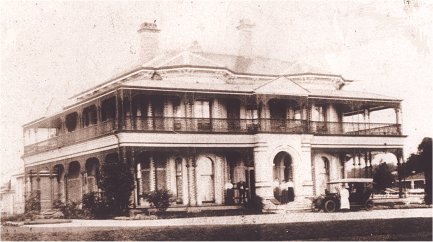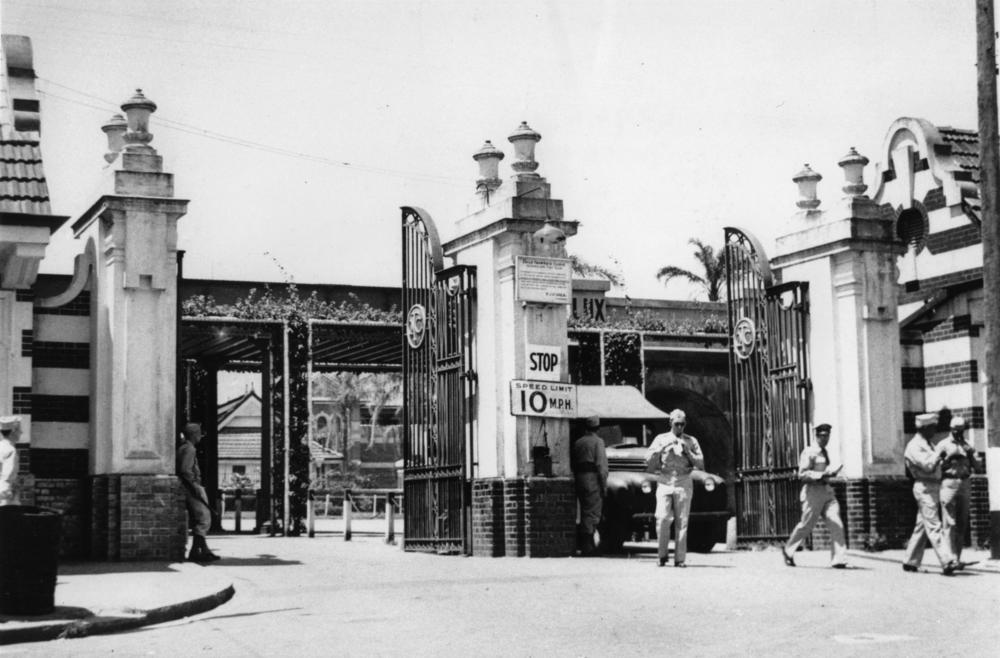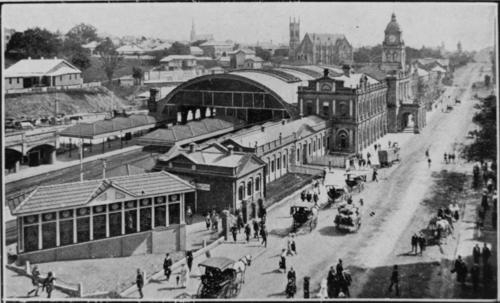|
Ascot Railway Station, Brisbane
Ascot railway station is located on the Pinkenba line in Queensland, Australia. It serves the Brisbane suburb of Ascot adjacent to Eagle Farm Racecourse. History Ascot station opened on 3 September 1882 as Hendra Siding coinciding with that of the Pinkenba railway line. It was later renamed Racecourse and eventually renamed as Ascot. The line was electrified on 6 February 1988. All passenger services on the line were suspended on 27 September 1993 as part of a statewide rationalisation of the rail network with the closing or suspending of under-utilised or unprofitable rail lines. Trains continued to serve Ascot when major race events were held. Passenger services resumed on 27 January 1998, but only as far as Doomben with bus connections to the other abandoned stations. Heritage listing A combined entry for Eagle Farm Racecourse and Ascot Railway Station was listed in the Queensland Heritage Register in 2004. Services Ascot station is served by all stops Doomben line se ... [...More Info...] [...Related Items...] OR: [Wikipedia] [Google] [Baidu] |
Ascot, Queensland
Ascot is a north-east suburb in the City of Brisbane, Queensland, Australia. In the , Ascot had a population of 5,777 people. Geography Ascot is characterised by large Queenslander homes and is located approximately north-east of Brisbane GPO. Ascot is best known for its beautiful old homes, the picturesque poinciana tree lined shopping area of Racecourse Road (), and for the Eagle Farm () and Doomben () racecourses popular for racing carnivals. Over a third of the suburb is taken up by Doomben and its related outer buildings, Eagle Farm and Doomben racecourses. Bartleys Hill is in the south-west of the suburb () and is above sea level. History Historically, the land was occupied by the Aboriginal Turrbal clan. The Turrbal called the area Yowoggerra, meaning ''corroboree place''. The clan had camping grounds on the north side of the Brisbane River around the Breakfast Creek area. It was at Breakfast Creek that explorers Oxley and Cunningham met members of the clan i ... [...More Info...] [...Related Items...] OR: [Wikipedia] [Google] [Baidu] |
Eagle Farm Racecourse And Ascot Railway Station
Eagle Farm Racecourse and Ascot Railway station is a heritage-listed pair of racecourse and railway station at 230 Lancaster Road, Ascot, City of Brisbane, Queensland, Australia. It was built from 1863 onwards. The racecourse is also known as Ascot Racecourse and Brisbane Racecourse, and Ascot railway station was previously known as Racecourse railway station. It was added to the Queensland Heritage Register on 25 June 2004. History The Eagle Farm Racecourse was established in 1863 and continues to operate as one of Queensland's premier racecourses. Additions and extensions include the establishment of the Pinkenba railway line (1882), the Paddock Stand (1889), the St Leger Stand (1913 with extensions in 1938), the Totalisator Building (1913 with extensions in the 1920s and 1950s), the entrance gates (1913), ticket boxes (1914), the Members' Stand (1925) and the John Power Stand (1958), as well as a number of other timber and brick buildings and timber stabling areas. Th ... [...More Info...] [...Related Items...] OR: [Wikipedia] [Google] [Baidu] |
Railway Stations In Brisbane
Rail transport (also known as train transport) is a means of transport that transfers passengers and goods on wheeled vehicles running on rails, which are incorporated in tracks. In contrast to road transport, where the vehicles run on a prepared flat surface, rail vehicles (rolling stock) are directionally guided by the tracks on which they run. Tracks usually consist of steel rails, installed on sleepers (ties) set in ballast, on which the rolling stock, usually fitted with metal wheels, moves. Other variations are also possible, such as "slab track", in which the rails are fastened to a concrete foundation resting on a prepared subsurface. Rolling stock in a rail transport system generally encounters lower frictional resistance than rubber-tyred road vehicles, so passenger and freight cars (carriages and wagons) can be coupled into longer trains. The operation is carried out by a railway company, providing transport between train stations or freight customer facil ... [...More Info...] [...Related Items...] OR: [Wikipedia] [Google] [Baidu] |
Railway Stations In Australia Opened In 1882
Rail transport (also known as train transport) is a means of transport that transfers passengers and goods on wheeled vehicles running on rails, which are incorporated in tracks. In contrast to road transport, where the vehicles run on a prepared flat surface, rail vehicles (rolling stock) are directionally guided by the tracks on which they run. Tracks usually consist of steel rails, installed on sleepers (ties) set in ballast, on which the rolling stock, usually fitted with metal wheels, moves. Other variations are also possible, such as "slab track", in which the rails are fastened to a concrete foundation resting on a prepared subsurface. Rolling stock in a rail transport system generally encounters lower frictional resistance than rubber-tyred road vehicles, so passenger and freight cars (carriages and wagons) can be coupled into longer trains. The operation is carried out by a railway company, providing transport between train stations or freight customer faciliti ... [...More Info...] [...Related Items...] OR: [Wikipedia] [Google] [Baidu] |
Doomben-Pinkenba Railway Line
The Doomben railway line is a railway line in the City of Brisbane, Queensland, Australia. It is the part of the Pinkenba railway line that still operates a regular passenger service. ''Doomben'', or ''dumben'', is the Indigenous Yuggera name for a tree fern which was prolific in the area. The railway line branches from the North Coast line at Eagle Junction, extending to the industrial suburb of Pinkenba, situated on the northern bank at the mouth of the Brisbane River. It is part of the Queensland Rail City network. History The initial section of the line opened on 3 September 1882 to Ascot (then named Racecourse) to serve the Eagle Farm racecourse, though nearby residents successfully lobbied for a regular passenger service. The line was extended to Pinkenba railway station in 1897, mainly to serve an industrial area, including wharves on the north side of the Brisbane River. The passenger service was timed to coincide with the starting and finishing times of the work ... [...More Info...] [...Related Items...] OR: [Wikipedia] [Google] [Baidu] |
Cleveland Railway Station
Cleveland railway station is located on the Cleveland line in Queensland, Australia. It serves the suburb of Cleveland in the Redland City. History In 1889, the Cleveland line was extended from Manly to the original Cleveland station. In 1897, the line was extended to the second Cleveland station. Cleveland station opened as the Raby Bay railway station in 1914. On 1 November 1960, the station closed when the line was truncated to Lota. When the station reopened on 24 October 1987, the former Raby Bay station became the third to carry the name Cleveland. Incidents On 31 January 2013, a passenger train, IMU173, overshot the railway line and collided with the station, severely damaging a toilet block and the railway station and injuring 14 people. The train was removed from the station in the early hours of the following morning. Services Cleveland is the terminus for Cleveland line services to and from Shorncliffe, Northgate, Doomben and Bowen Hills. Services by platfo ... [...More Info...] [...Related Items...] OR: [Wikipedia] [Google] [Baidu] |
Park Road Railway Station
Park Road railway station is the junction station for the Gold Coast and Cleveland lines in Queensland, Australia. It serves the Brisbane suburb of Woolloongabba. It is served by Beenleigh, Cleveland and Gold Coast line services. Immediately south of the station lies a triangle junction with the Cleveland and Fisherman Islands lines branching off. History In September 1930, the standard gauge NSW North Coast line opened to the west of the station. On 12 November 1942, a wartime siding opened at Park Road, followed by a second on 28 February 1944. After falling out of use in 1945, the yard was reactivated in 1949. In its later years, it was primarily used by paper trains for Queensland Newspapers. It closed again in the early 1990s. As part of the construction of the Gold Coast line, the standard gauge line was converted to dual gauge to allow these services to be segregated from Beenleigh and Cleveland services. In 2000, a project commenced to add a fourth track and platfor ... [...More Info...] [...Related Items...] OR: [Wikipedia] [Google] [Baidu] |
Roma Street Railway Station
Roma Street railway station is located in the Brisbane central business district, Queensland, Australia. It is the junction station for the North Coast railway line, Queensland, North Coast, Main Line railway, Main, Gold Coast railway line, Gold Coast and North Coast railway line, New South Wales, NSW North Coast lines. The station is one of four inner city stations that form a core corridor through the centre of Brisbane. Although not easily visible to the public, the original Roma Street railway station building, 1873 Roma Street railway station building still exists within the modern complex and is listed on the Queensland Heritage Register. History 1800s to 1940s The construction of a railway station on Roma Street, Brisbane, Roma Street was part of a plan to extend the Main Line railway, Main Line to Brisbane. An iron station building designed by Charles Fox (civil and railway engineer)#Freeman Fox & Partners, Hyder Consulting, Sir Charles Fox & Sons was to be imported ... [...More Info...] [...Related Items...] OR: [Wikipedia] [Google] [Baidu] |
Queensland Heritage Register
The Queensland Heritage Register is a heritage register, a statutory list of places in Queensland, Australia that are protected by Queensland legislation, the Queensland Heritage Act 1992. It is maintained by the Queensland Heritage Council. As at 5 April 2020 there are 1790 places on the Queensland Heritage Register, including the Story Bridge in Brisbane and the Ross River Meatworks Chimney in Townsville. Criteria For a place to be entered in the register, it must be nominated and then go through a process of assessment. There are three categories for inclusion: * State Heritage Place (the most common type of entry), e.g. the Charters Towers Courthouse * Archaeological Place, e.g. the First Brisbane Burial Ground in the vicinity of Skew Street, Brisbane * Protected Area, e.g. the shipwreck of the on Fraser Island Criteria for inclusion as a State Heritage Place For inclusion as a State Heritage Place on the Queensland Heritage Register, the place must satisfy one of the fo ... [...More Info...] [...Related Items...] OR: [Wikipedia] [Google] [Baidu] |
Doomben Railway Station
Doomben railway station is the terminal station of the Pinkenba line in Queensland, Australia. It serves the Brisbane suburb of Ascot adjacent to Doomben Racecourse. History The Pinkenba line opened on 1 April 1897 to Pinkenba. A station for Doomben Racecourse was opened in 1909 alongside the Nudgee Road level crossing, and in 1976 a new station named Whinstanes-Doomben opened slightly farther east; Whinstanes was the name of the industrial branch line that crosses Kingsford Smith Drive to the Hamilton Cold Stores. The station was renamed Doomben when the line was electrified on 6 February 1988. All passenger services on the line were suspended on 27 September 1993 as part of a statewide rationalisation of the rail network with the closing or suspending of under-utilised or unprofitable rail lines. Trains continued to serve Doomben when major race events were held. Passenger services resumed on 27 January 1998, with Doomben becoming the terminal station with bus connectio ... [...More Info...] [...Related Items...] OR: [Wikipedia] [Google] [Baidu] |
Central Railway Station, Brisbane
Central railway station is located on the North Coast line in Queensland, Australia. It is the principal station on the City network and is located in the north of the Brisbane central business district. Central station is one of four inner city stations that form a core corridor through the centre of Brisbane. History The first building for Central railway station was a structure of wood and corrugated galvanised iron, and opened on 18 August 1889 as the terminus of the line when it was extended from Roma Street railway station. In 1891, the tunnel to Brunswick Street station (now Fortitude Valley) was opened so trains could run directly from Central to northern destinations. An elegant new station was constructed and opened in 1899 with arches of corrugated galvanised iron over the platforms and a portico on Ann Street. A new entrance with its distinctive row of clocks was constructed in 1901 in sandstone from nearby quarries. In 1904, Central had the only electro-pne ... [...More Info...] [...Related Items...] OR: [Wikipedia] [Google] [Baidu] |
Rationalization (economics)
In economics, rationalization is an attempt to change a pre-existing ad hoc workflow into one that is based on a set of published rules. There is a tendency in modern times to quantify experience, knowledge, and work. Means–end (goal-oriented) rationality is used to precisely calculate that which is necessary to attain a goal. Its effectiveness varies with the enthusiasm of the workers for the changes being made, the skill with which management applies the rules, and the degree to which the rules fit the job. Rationalization aims at an efficiency increase by better use of existing possibilities: A same effect can with fewer means, or with same means to be obtained. In the industry thereby frequently the replacement of manpower is designated by machines (rationalization investment). It is the reasonable, appropriate organization of operational conditions under changing conditions to increase with the goal, productivity and economy. Julien Freund defines rationalization as "the org ... [...More Info...] [...Related Items...] OR: [Wikipedia] [Google] [Baidu] |





